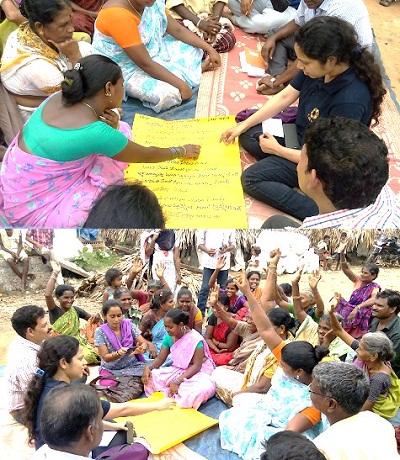DISASTER RESPONSE

Last month I had the opportunity to visit some of the Hudhud cyclone affected villages and urban slums of Vishakhapatnam where CARE is helping people recover from the impact of cyclone Hudhud.
As I started my journey the images of loss and destruction that I had seen during my earlier visit post cyclone started flashing in front of my eyes. I was anxious and excited at the same time, waiting to see the situation now hoping to see a change.
Eklavya Nagar colony in Vishakhapatnam is a slum inhabited by a bunch of wonderful human beings with a spark in their eyes and a dream of a better life. To reach this colony one has to take a detour off the main road and continue on the Kuchcha road for about 15 to 20 minutes before one sees a constellation of thatched huts. The majority of population belongs to Chenchu tribe. This slum is highly prone to flood of back water of Megadhrigedda stream. This was one of the slums hit badly by the Hudhud cyclone in October 2014. The inhabitants had evacuated to a nearby Mandal to save their lives, leaving behind all their belongings including clothes, cooking vessels, and other valuables in the colony. After one week, they returned to see the damaged huts and debris all over on the roads. Most of the families in this slum are dependent on daily wage labour and earn their livelihood through small enterprises such as selling plastic utensils, making bamboo and other crafts and selling phenol.
As I entered the colony I was pleasantly surprised by the smiling faces, clean road, thatched huts standing organised as if nothing had ever happened there. I was introduced to Sudha Rani and Ramanayya as the Secretary and the President of the Social Monitoring Committee (SMC). Soon there were more members introduced. There was a sense of pride on their faces while sharing that they belonged to the SMC.

Social Monitoring Committees: As a part of Emergency Response to Cyclone Hudhud (ERCH), social monitoring committees (SMCs) were formed by CARE in 13 villages/slums. SMCs represent the affected population with 50% of women members. Representation of all castes and marginalised groups including persons with disability are also included. This was envisioned as a step to promote effective participatory, transparent and accountable management of response interventions with agreed procedures. The project organized Social Monitoring Committee formation and strengthening programmes in Vishakhapatnam and Vizianagaram. SMC module was developed in the regional language (Telugu) with pictorial presentations, songs and games in order to achieve easy understanding and outreach.
SMCs play a vital role in beneficiary selection, supporting assessments, monitoring the progress on various interventions, conflict resolution, recommending and authorising the release of funds for shelter repair based on stages of completion of work. The committee also manages a register for resolutions, attendance and minutes of meetings. After the formation of SMC, many bank accounts were opened. SMCs have been instrumental in collectivising the voice of the people.
Going beyond the project activities: I was curious to know if the SMC would be of any value after the project is over. Roothamma, a member of SMC shared happily that the committee is not just looking at the project activities but during the committee meetings, they also discuss issues like access to health and electricity. There was a lady who needed healthcare but could not afford it, so the committee discussed the matter and decided to support the lady by pooling resources. The members said the committee meetings give them an opportunity to discuss important issues. During a visit to another slum I came to know that the SMC was able to bring down the cost of transportation of shelter materials per person to one fourth of the cost originally demanded by the vendor, when they negotiated jointly. Through the SMC, people are taking collective action not only towards resilience but also other issues of importance. This includes negotiating with service providers/ Government for access to quality service.
CARE has a practice of constituting project monitoring committees comprised of the beneficiary community members during emergency response projects. The ERCH project has however gone a step forward by strengthening these committees, developing modules and developing songs, games and pictures to motivate and spread awareness about the importance of such committees. Thus the process has strengthened local governance, especially, in making people’s voices heard.




